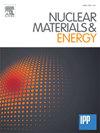X-point radiation: From discovery to potential application in a future reactor
IF 2.7
2区 物理与天体物理
Q1 NUCLEAR SCIENCE & TECHNOLOGY
引用次数: 0
Abstract
Power exhaust is a crucial issue for future fusion reactors. Divertor detachment and the required power dissipation fractions of about 95% are foreseen to be achieved by impurity seeding. In a tokamak, at high seeding levels the radiation often concentrates in a small region inside the confined plasma near the X-point. In early observations the so-called X-point radiator (XPR) often led to back-transitions to L-mode or disruptions. In metal tokamaks or with higher available heating power, these regimes can be stabilized and are now established on AUG, JET, TCV, KSTAR and WEST.
The XPR is a cold, dense plasma inside the confined region in the vicinity of the X-point, that breaks the paradigm of poloidal symmetry of density and temperature on closed flux surfaces. On AUG, the poloidal extent of the XPR is a few centimeters and it is observed up to 15 above the X-point. The long connection length in this region and the access of neutral particles from the divertor region facilitate the creation of the XPR, as predicted by an analytical model. Numerical simulations with SOLPS-ITER match the observations at AUG and TCV and allow predictions towards a power plant, where a lower impurity concentration is required to trigger an XPR. Since the XPR greatly reduces power and particle fluxes to the targets, simpler and more efficient divertor concepts, such as the compact radiative divertor, can be envisaged for future devices. A scenario with an XPR, however, comes at the cost of an increased impurity concentration and a potential reduction in confinement, which has to be further quantified.
The XPR location can be well detected by various diagnostics, enabling responsive real-time control, even through large transients like an LH transition. The active control helped to access a new regime of ELM suppression at AUG, which is now also observed at TCV and JET.
The observation of the XPR on multiple tokamaks, the demonstration of its active control, and the emergence of theoretical models that scale favourably towards fusion reactors have opened up a new phase of advanced power exhaust research.
x点辐射:从发现到未来反应堆的潜在应用
功率耗尽是未来聚变反应堆的一个关键问题。可以预见,通过添加杂质,可以实现掺混器分离和所需的约 95% 的功率耗散分数。在托卡马克中,当种子水平较高时,辐射通常会集中在封闭等离子体内部靠近 X 点的一小块区域。在早期的观测中,所谓的 X 点辐射器(XPR)经常导致向 L 模式的反向转换或中断。在金属托卡马克或更高的可用加热功率下,这些状态可以被稳定下来,现在已经在AUG、JET、TCV、KSTAR和WEST上建立起来。XPR是X点附近约束区域内的冷致密等离子体,它打破了封闭通量面上密度和温度的极对称范式。在 AUG 上,XPR 的极坐标范围为几厘米,在 X 点上方 15 c m 处可以观察到。正如分析模型所预测的那样,该区域的长连接长度和中性粒子从分流区的进入促进了 XPR 的产生。利用 SOLPS-ITER 进行的数值模拟与在 AUG 和 TCV 的观测结果相吻合,并可对发电厂进行预测,在发电厂,需要较低的杂质浓度才能触发 XPR。由于 XPR 大大降低了目标的功率和粒子通量,因此可以为未来的装置设想更简单、更高效的分流器概念,如紧凑型辐射分流器。不过,使用 XPR 的方案需要以增加杂质浓度和可能降低约束性为代价,这一点还需要进一步量化。XPR 的位置可以通过各种诊断仪很好地检测到,从而实现响应式实时控制,即使是在 LH 转变等大的瞬态情况下也是如此。在多个托卡马克上观测到的 XPR、其主动控制的演示以及有利于聚变反应堆扩展的理论模型的出现,开启了先进功率排气研究的新阶段。
本文章由计算机程序翻译,如有差异,请以英文原文为准。
求助全文
约1分钟内获得全文
求助全文
来源期刊

Nuclear Materials and Energy
Materials Science-Materials Science (miscellaneous)
CiteScore
3.70
自引率
15.40%
发文量
175
审稿时长
20 weeks
期刊介绍:
The open-access journal Nuclear Materials and Energy is devoted to the growing field of research for material application in the production of nuclear energy. Nuclear Materials and Energy publishes original research articles of up to 6 pages in length.
 求助内容:
求助内容: 应助结果提醒方式:
应助结果提醒方式:


